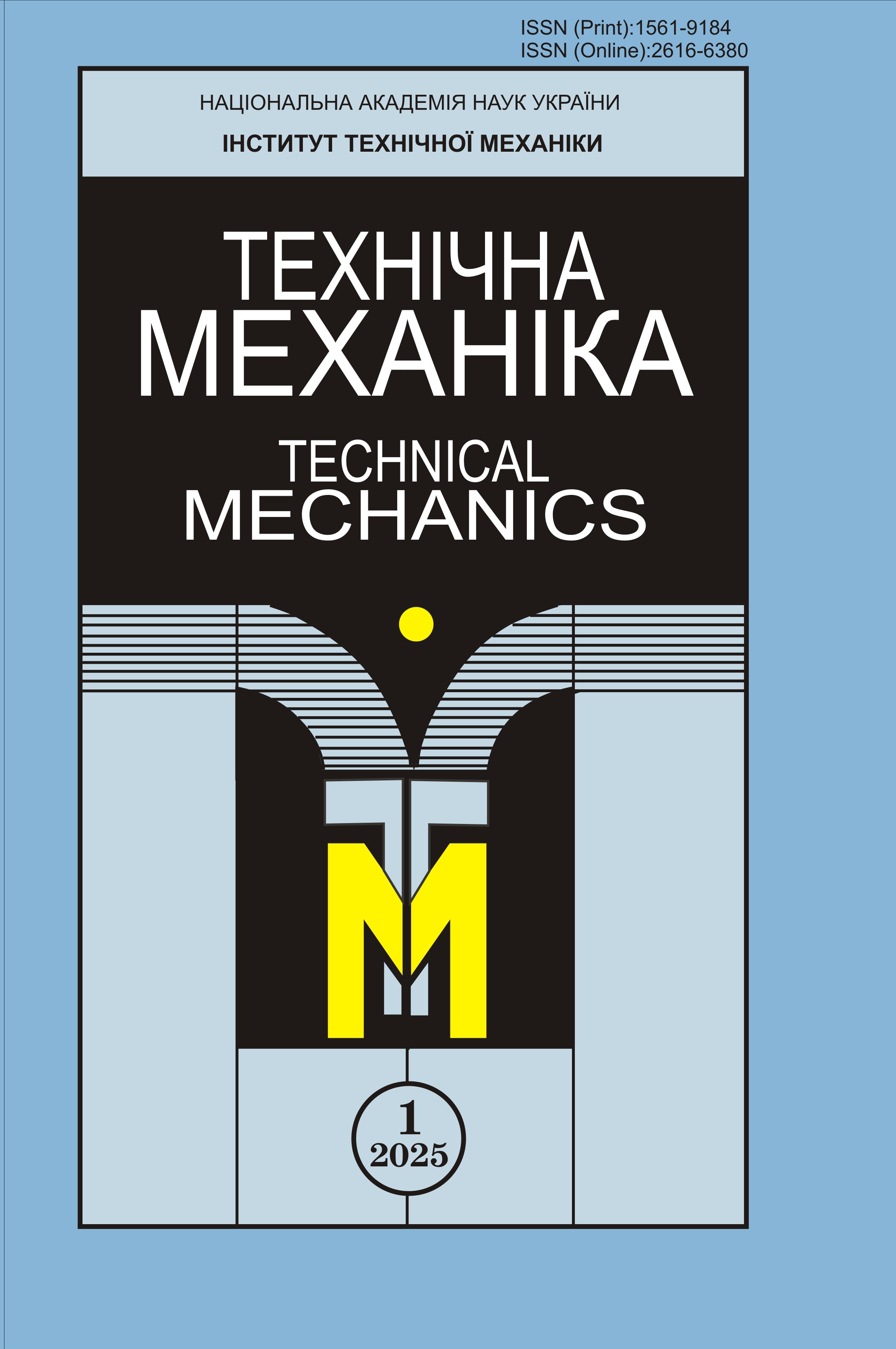SPEED STABILIZATION OF A DARRIEUS ROTOR OF A VARIABLE MOMENT OF INERTIA CONTROLLED BY VARIATIONS OF THE TRAVERSE LENGTH
Keywords:
wind power plants, Darier rotor, rotation stabilization, variable moment of inertia, stability, operability, mathematical simulation.Abstract
DOI: https://doi.org/10.15407/itm2025.01.089
Vertical-axis wind turbines (VAWTs) have become widespread in the modern world. Traditionally, to ensure the optimal operation of wind turbines, various types of generators are used as control system actuators, which control the rotor speed by energy dissipation when the wind speed increases or by speeding up the rotor when the wind speed decreases. As a rule, the rotors of such systems have a fixed configuration, which ensures simplicity in design and solution of control problems in various operating modes. This approach overloads the transmission, causes elastic vibrations of its high-speed and low-speed shafts, and complicates control algorithms. As a possible way out, ever increasing use is made of control methods based on varying the aerodynamic properties of the rotor. This adapts the system to the operating conditions, namely to variations in wind speed. The rotor aerodynamics can be varied in two ways: by varying the blade angle or by varying the rotor configuration (by varying the length of the blades and traverses). Varying the blade length does not complicate the rotor dynamics model as a control object. To stabilize the rotor speed in this case, use is made of proportional plus integral (PI) or proportional plus integral plus derivative (PID) controllers, whose stable operation conditions the authors considered earlier. It was demonstrated that the rotor models where the rotor as a control object is controlled by varying the blade length and by varying the traverse length are dynamically similar on condition that the variations of the traverse length from its nominal value are small. An approach to and a procedure for ensuring the smallness of these variations by redistributing loads between the stabilization channels in their joint operation were developed. Restricting oneself to the case of small variations gives no way to use the potentialities of the rotor as a system that converts wind energy to mechanical and then to electric energy. A more complete use of system potentialities calls for considering the possibility of its operation at significant variations of the traverse length from its nominal value. The difficulties that arise in doing so involve the complication of the dynamic model of the rotor as a control object due to significant time variations of its moment of inertia. The goal of this paper is to develop a dynamic model of the Darrieus rotor as a control object that would account for significant variations of the transverse length from its nominal value and associated variations of the moment of inertia and to synthesize and analyze the effectiveness of Darrieus rotor speed stabilization algorithms for VAWTs operable in the above-mentioned conditions. The problem is solved using methods of classical theory of automatic control and mathematical simulation. The obtained results are new in a generalization of the concept of swept-area variation control to Darrieus rotor VAWTs controlled by significant variations of the traverse length and associated variations of the moment of inertia and in the synthesized efficient rotor speed stabilization algorithms for them. The proposed algorithms and methods may be used in the design of promising VAWTs of different capacities.
REFERENCES
1. Dzenzersky V. A., Tarasov S. V., Kostyukov I. Yu. Low-Power Wind Plants. Kyiv: Naukova Dumka, 2011. 592 pp. (In Russian).
2. Subbota A. M., Dzhulgakov V. G. Increase of efficiency of wind power plant with vertical axis of rotation. Radioelectronic and Computer Systems. 2018. No. 1(85). Pp. 77-86. (In Russian).
3.Tarasov S. V., Redchyts D. O., Tarasov A. S., Dorosh O. V. Model of variable-configuration Darrieus rotor dynamics. Proceedings of the International Conference "Information Technologies in Metallurgy and Mechanical Engineering" (ІТММ-2023). 22 March 2023. Dnipro: Ukrainian State University of Science and Technologies, 2023. Pp. 208-211. (In Ukrainian).
4. Tarasov S. V., Molotkov O. N. Algorithms for stabilizing the rotor speed of a Darrieus wind power plant controlled by blade length variation. Teh. Meh. 2023. No. 4. Pp. 50 - 59. (In Ukrainian).
https://doi.org/10.15407/itm2023.04.050
5. Tarasov S. V., Molotkov O. N. Model of the dynamics of a Darrieus rotor controlled by traverse length variation. Proceedings of the 15th International Scientific and Practical Conference "Modern Power Plants in Transport and Technologies and Equipment for their Maintenance" (MPPTTEM-2024). 13-15 March 2024. Kherson: Kherson State Marine Academy, 2024. Pp. 224-226. (In Ukrainian).
6. Tarasov S. V., Molotkov O. N. Darrieus rotor speed stabilization by joint variation of the blade and the traverse length. Teh. Meh. 2024. No. 2. Pp. 92-105. (In Ukrainian).
https://doi.org/10.15407/itm2024.02.092
7. Kartašovas V., Barzdaitis V., Mažeika P. Modeling and simulation of variable inertia rotor. Journal of Vibroengineering. 2012. V. 14. Iss. 1. Pp. 67-72.
8. Zukovic M. Dynamics of mass variable rotor and its application in modeling tuning operation. Acta Mechanica. 2021. V. 232. Рp. 1605-1620.
https://doi.org/10.1007/s00707-020-02918-x
9. Tiago Andre dos Santos Marques. Control and Operation of a Vertical Axis Wind Turbine. Dissertacao. 2014. 83 pp. URL: https://fenix.tecnico.ulisboa.pt/downloadFile/844820067124338/dissertacao.pdf (Last accessed on June 17, 2023).
10. Artobolevsky I. I. Theory of Mechanisms and Machines. Moscow: Nauka, 1988. 640 pp. (In Russian).
11. Shtanko P. K., Shevchenko V. H., Omelchenko O. S., Dziuba L. F., Pasika V. R. Poliakov O. M. Theoretical Mechanics. Zaporizhzhia: Zaporizhzhia Polytechnic National University, 2021. 464 pp. (In Ukrainian).
12. Rozenvasser E. N., Yusupov R. M. Control System Sensitivity. Moscow: Nauka, 1981. 464 pp. (In Russian).
13. Besekersky V. A., Popov E. N. Theory of Automatic Control Systems. Saint Petersburg: Professiya, 2003. 752 pp. (In Russian).
14. D'Angelo H. Linear Time-Varying Systems: Analysis and Synthesis. Moscow: Mashinostroyeniye, 1974. 288 pp. (In Russian).






